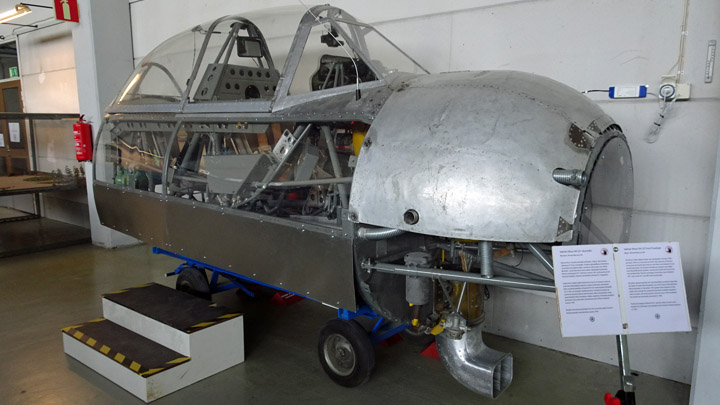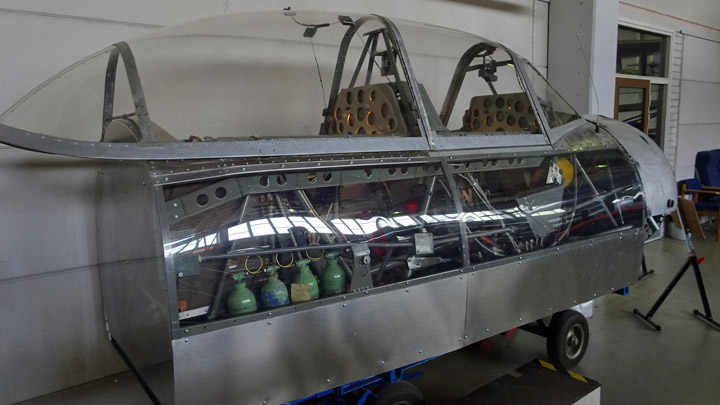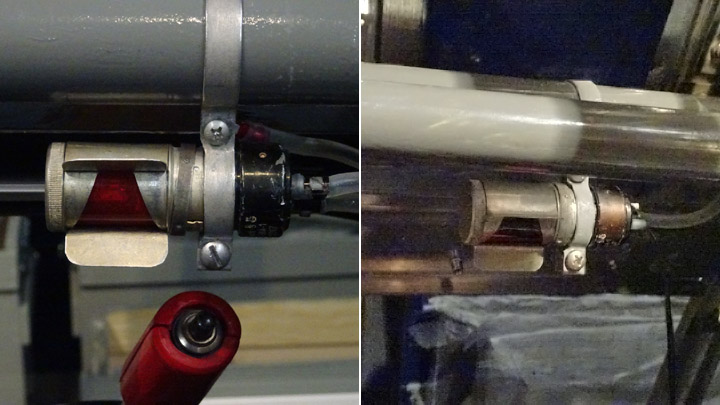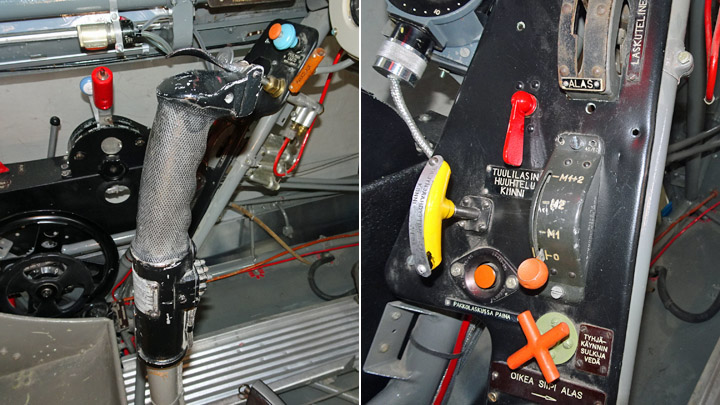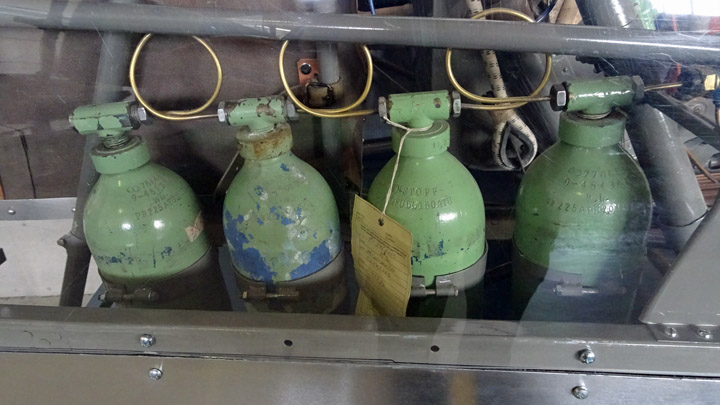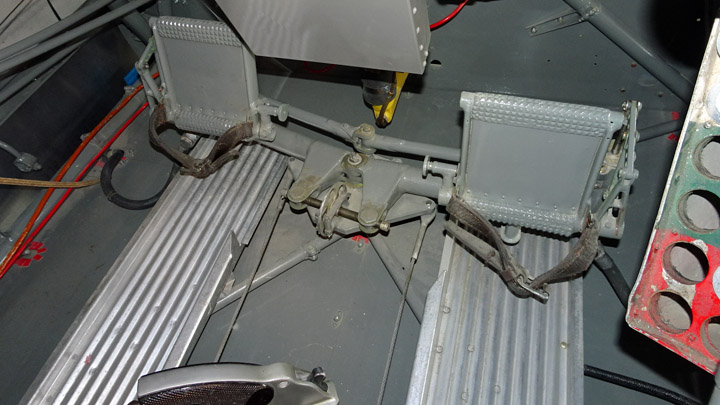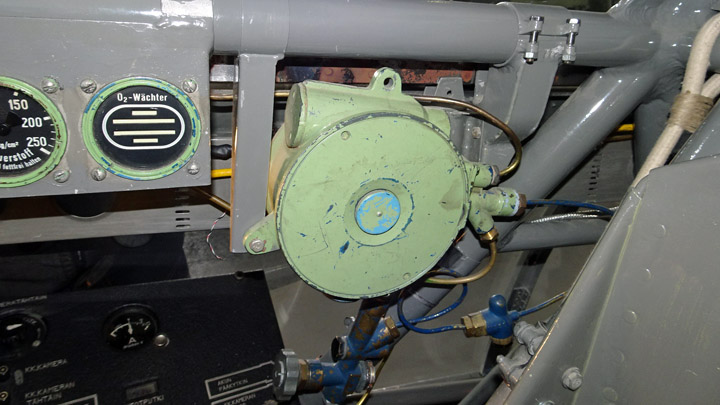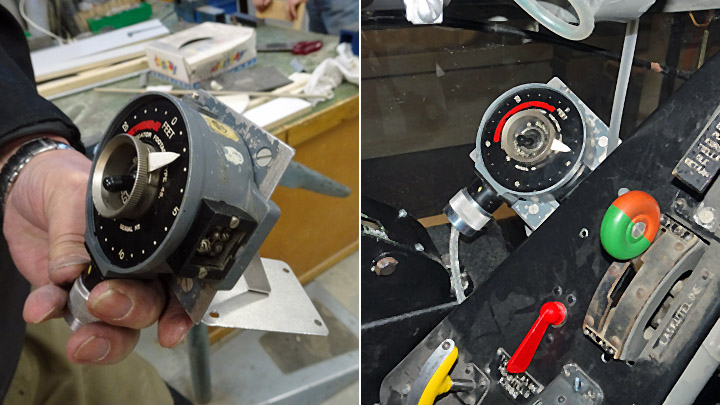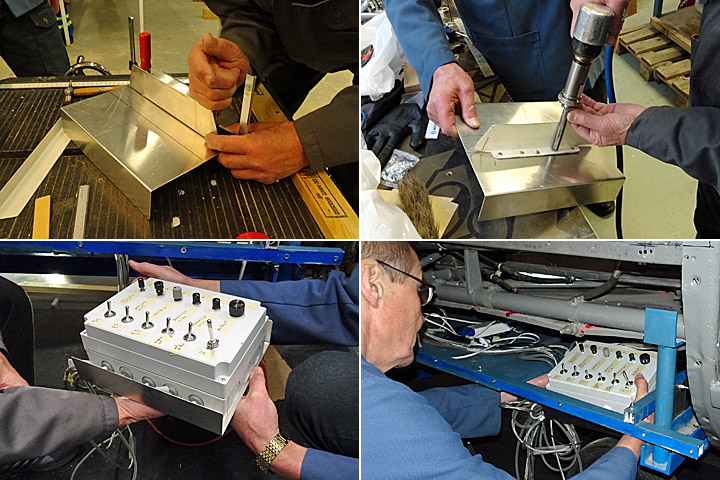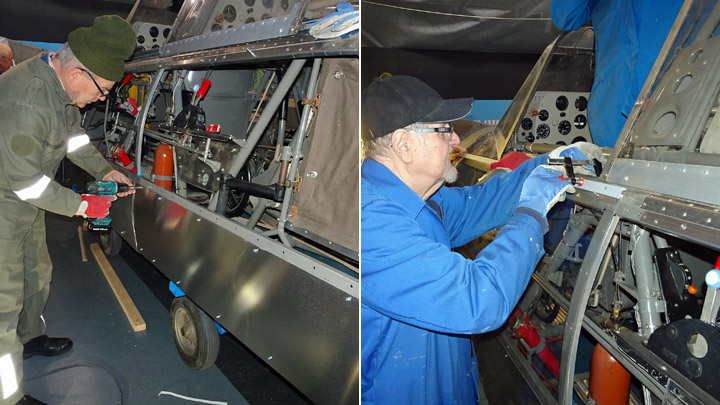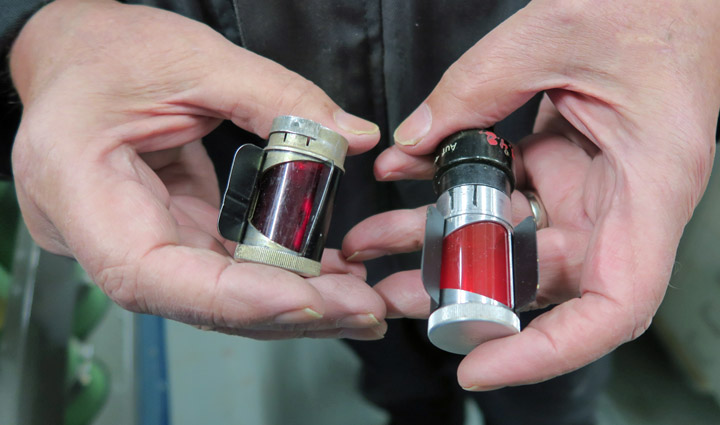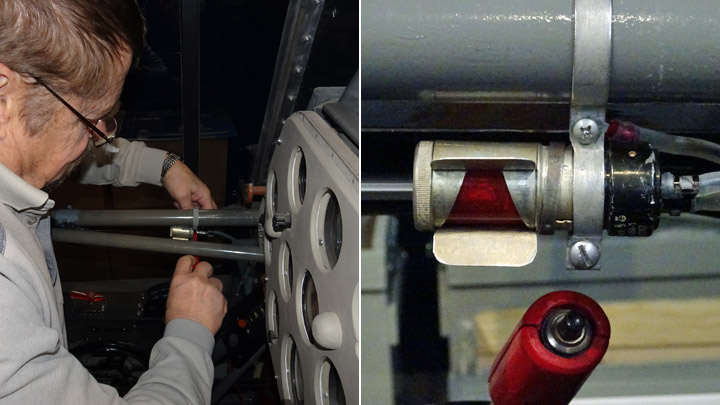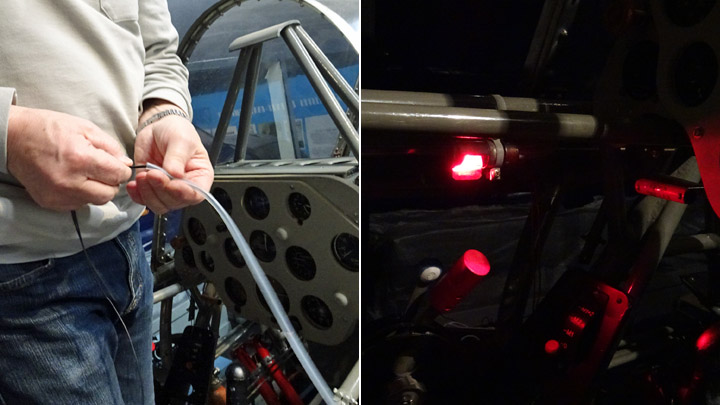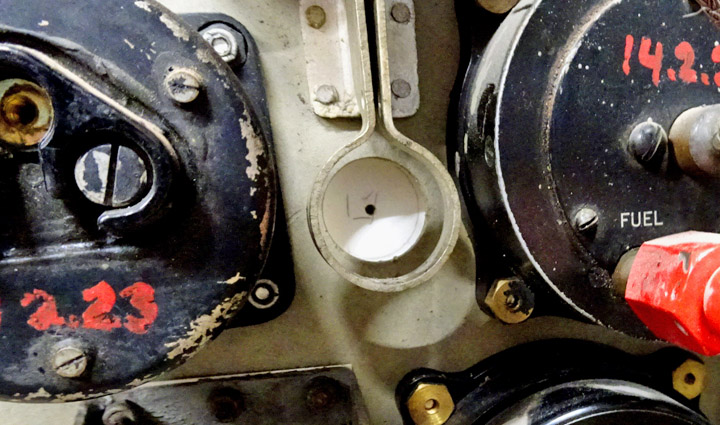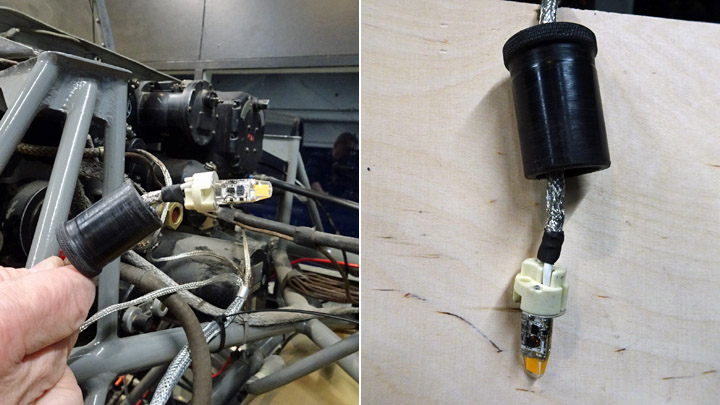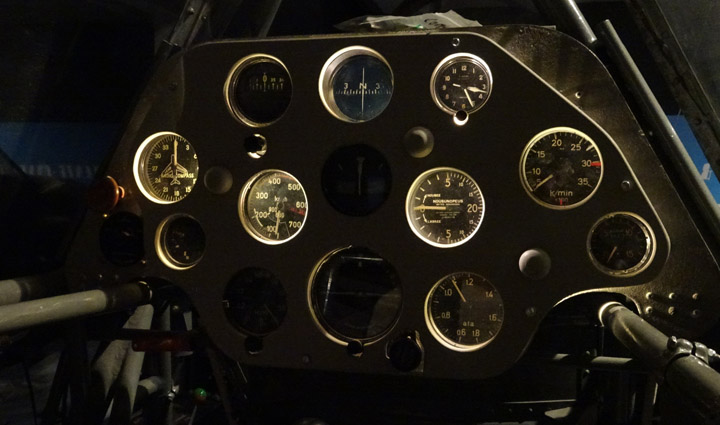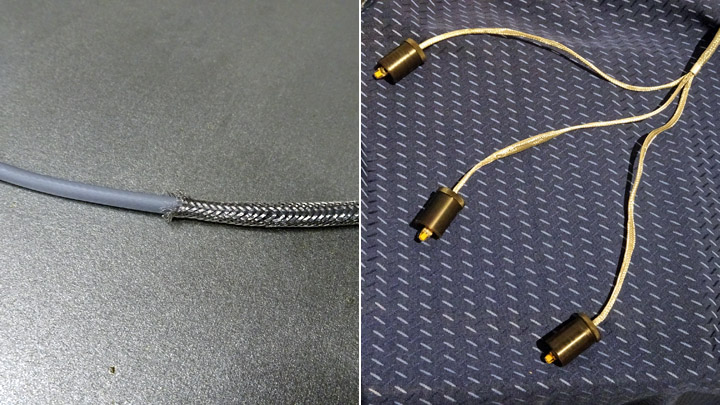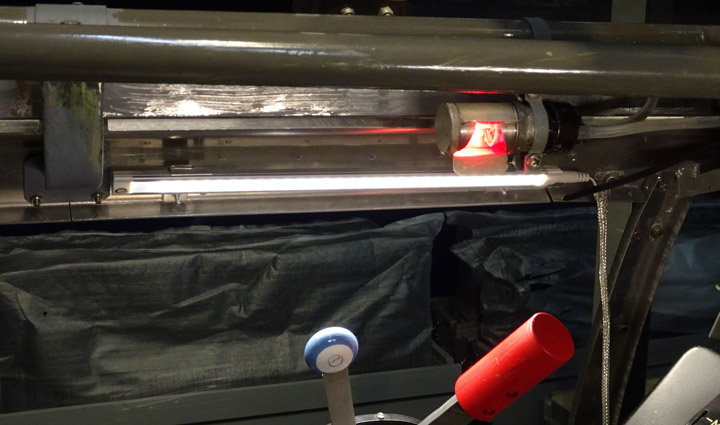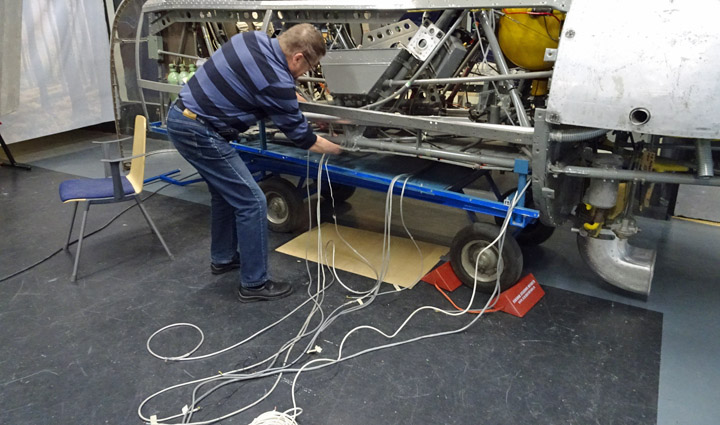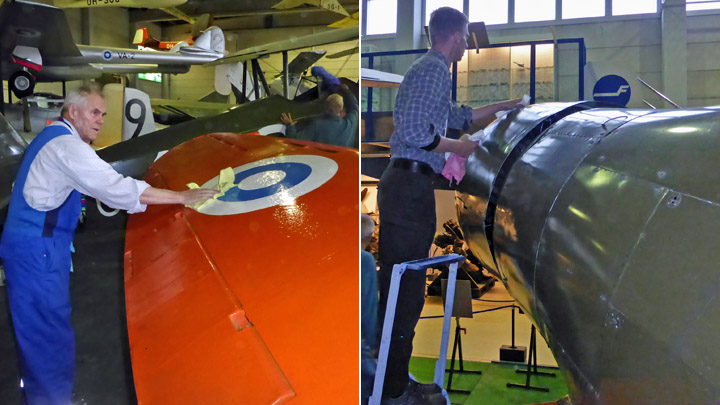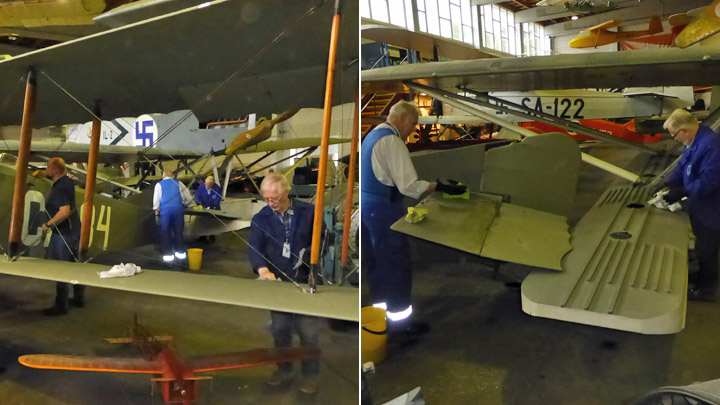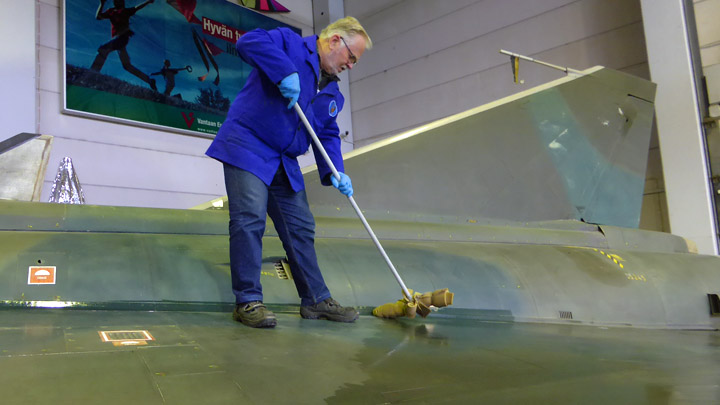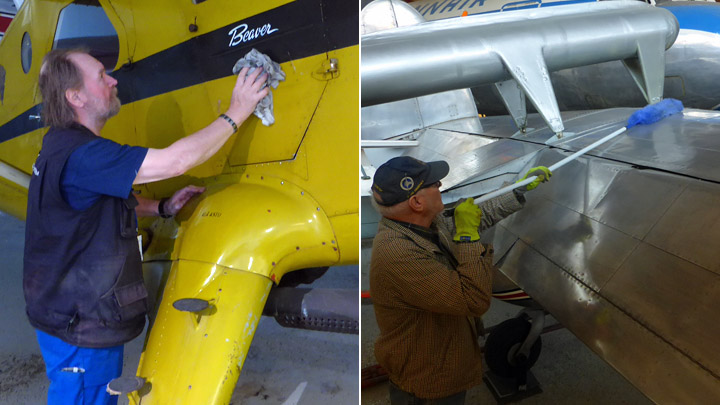Cockpit part of Valmet Vihuri II on display at Finnish Aviation MuseumLauantai 12.5.2018 - Member of Tuesday Club The Finnish Aviation Museum Society’s Tuesday Club project to restore the Valmet Vihuri II (VH-25) front fuselage has taken almost twenty years. Now the restored part with front and rear cockpits is ready and on display in Hall I at the Finnish Aviation Museum.
The restored Vihuri front fuselage is based on the front cockpit and the engine mounting of VH-25 which were found in a scrapyard in Helsinki in the 1970’s and purchased to the Finnish Aviation Museum. The cockpit had some equipment and wind screen and the engine mounting had some fairing plate remaining. The restoration project started in the late 1990’s but was interrupted for a while and started again with full speed in the early 2000’s. The front fuselage found in the scrapyard had only the front cockpit so the rear cockpit with its pilot’s seat had to be built following the original Vihuri drawings. Cockpit equipment and instruments found in the collections of the Finnish Aviation Museum and the Finnish Air Force Museum have been installed in the cockpits. The Tuesday Club team is grateful for the assistance of both museums for supplying the material. The Tuesday Club team built several new items for the cockpit, including the luggage compartment, map holder and flare gun with its launching tube. The front fuselage of Valmet Vihuri II with its cockpits and its equipment is now in the Finnish Aviation Museum, on display for the visitors. The only remaining whole Vihuri (VH-18) I s in the Finnish Air Force Museum. However, the front part of VH-25 in the Aviation Museum offers the visitors something that the VH-18 in the Air Force Museum doesn’t.
The restored front fuselage of VH-25 is mainly covered with transparent plexi, not aluminium plate. Therefore the museum visitor can clearly see what equipment and instruments the Vihuri has.
The cockpit and display lighting is on, as well as the lights in the sight. Above the front seat there is a mirror for having a good view of the sight and its light cross.
The cockpit equipment and instruments in Vihuri are interesting because they originate from earlier plane types used in the Finnish Air Force. When the Vihuri’s were originally built, parts were installed from dismantled Air Force planes. For example the stick in the front cockpit of the Vihuri, the magneto selection switch, the red cockpit light and parts of the oxygen supply system (the regulator, the flow and pressure indicators and valve) come from Messerschmitt Bf 109.
The oxygen bottles of Vihuri are probably from Junkers Ju 88. The rudder pedals in the front cockpit are from VL Myrsky.
The instruments in the instrument panel come from several different planes. The manual pump of the pressurized oil system is from Bristol Blenheim. Unfortunately there is no Bristol Mercury motor available in Finland, so the restored VH-25 has no motor. As you can see, recycling of equipment and instruments has been a key issue in the building of Vihuri.
Welcome to the Finnish Aviation Museum to see the front fuselage of Valmet Vihuri II, restored by the Tuesday Club. Photos: Lassi Karivalo. |
|
Avainsanat: aviation history, Tuesday Club, museum aircraft, Valmet Vihuri, VH-25 |
Vihuri cockpit on final phaseSunnuntai 4.3.2018 - Member of Tuesday Club The cockpit of VL Vihuri (VH-25) will soon be placed on display at the Finnish Aviation Museum. The last phase in the cockpit restoration work includes the side coverings. The sides are covered with aluminium plate and plexiglass so that the museum visitor is able to have a view inside the cockpit and see all the equipment there.
While the covering of the sides has been going on, the last of the cockpit equipment have been installed. The Tuesday Club was able to get hold of a machine gun camera control unit which has been in a Vihuri. The only problem was that the unit didn’t have the bracket which is needed to attach it to the instrument panel on the left side of the front cockpit. There was no information available about the original bracket. Therefore the bracket was designed by the Tuesday Club and built using aluminium. The bracket has now been made and the control unit is ready to be installed.
The cockpit and display lighting was completed before Christmas. The finalisation and installation of the lighting control unit was left to be done later. A container was made from aluminium plate to house the lighting control unit. The whole package was installed on the supporting frame under the front cockpit. The lighting control unit was placed behind the cockpit side covers, hidden from view and also protected from possible vandalism.
The covering of the lower parts of the cockpit sides using 1.5 mm aluminium plate has been completed. The aluminium plates cover half of the cockpit sides. The plates were attached at their lower edge to the supporting structure’s hem under the cockpit. The upper edge of the plates was attached to the covering panel which runs along the side of the cockpit. The upper sides of the cockpit will be covered using transparent plexiglass. The plexi installation has already been started. Photos: Lassi Karivalo |
|
Avainsanat: aviation history, Tuesday Club, museum aircraft, Valmet Vihuri, VH-25 |
Lights installed in Vihuri (VH-25) cockpitKeskiviikko 20.12.2017 - Member of Tuesday Club The last phases in the restoration work of the Valmet Vihuri II (VH-25) cockpit included the installation of the cockpit lights, the instrument board background lights, the light of the sight and the display lights when the cockpit is in the museum. Finally the sides of the cockpit will be covered with aluminum plate and plexiglass. Originally the Vihuri had a 24V direct current electrical system. The positive pole of the system was insulated from the fuselage of the plane and the negative pole was connected to the fuselage. However, in the restoration of the Vihuri cockpit a 12 V alternating current system was chosen. In this system both poles of the system are insulated from the fuselage. The mains voltage (240 V AC) is transformed into a low voltage (12 V) and rectified to direct current. This power supply (12 V DC) is connected to the Vihuri lighting control panel, which supplies power to each lighting fixture. The front and rear cockpits of the Vihuri has small red lights on both sides of the cockpit. The light is tinted red in order to disturb the pilots’ night vision as little as possible when flying in dusk or in darkness. The amount and direction of light can be adjusted simply by turning the shade around the glass of the lighting fixture.
Three original cockpit lights were available and could be installed into the VH-25 cockpits, but the fourth lighting fixture was missing and had to be made. Fortunately the base of the fourth light was found. The body, the glass and the turning shade of the lighting fixture had to be made to resemble the original ones. The body was made of aluminum, the “glass” was cut from red plastic and the cover was made from aluminum plate.
When the fourth cockpit lighting fixture was ready, all four lights were installed in the cockpit by attaching them to the original fasteners in the upper parts of both cockpits. The original incandescent lamps were replaced by led lamps. Leds were chosen because the cockpit lights are always on when the VH-25 cockpit is on display in the museum and the heat emitting incandescent lamps wouldn’t be a good solution. Installing the led lamps into the original lighting fixtures wasn’t a problem because the leds have the same type of socket (BA 15d) as the original incandescent lamps.
The original power cables of the four cockpit lights in the Vihuri are protected by transparent plastic tubes. A similar installation was chosen in the restoration work, but using similar thin silicon tube. In the original installation there were two cables (positive and negative) from each lighting fixture installed into the plastic tube and the negative cable was connected to the fuselage. The cabling was changed so that both cables are inside the tube and they connect the lighting fixtures to the lighting control panel. The red lights were turned on when the power was connected.
Three background lights were installed behind each instrument board. Unfortunately there were no original background lights available and all of them had to be made. Fortunately the instrument boards still had the clips for the lighting fixtures so that the size and shape of the lighting fixture could be estimated.
The tube-shaped bodies of the lighting fixtures were lathed from plastic. A cable was pulled through the body and the wires were attached to the base of the fixture. Led lamps with G4 caps were attached to the base. When power was supplied to the cables, the background lights illuminated the instrument boards.
The cabling was made by using one cable from the lighting control panel to each instrument panel. According to the drawings of the original installation, the wiring was branched at the instrument panel to supply each of the three lighting fixtures. The light of the sight was installed in a similar way.
In the Vihuri the background lights of the instrument boards and the sight light had originally armored cables. The armor, i.e. the braided metal covering of the cables, was meant to protect the power supply from disturbing external signals. However, the armored cable used in the restoration work of the instrument panel lights had three cables whereas the original one had only two. Therefore the three-wire cable was pulled out of the armor and replaced by the two wires leading to the instrument board lights. At the same time the armor was stretched in order to make it thinner, resembling the original one used in the Vihuri.
The Vihuri cockpit will be on display in the Finnish Aviation Museum. The red lights in the cockpits, the instrument board lights and the sight light were adequate for the pilots but they won’t be able to illuminate the cockpit enough for the museum visitors. Therefore four 30 cm long led tubes were installed as display lighting. The leds were attached to the upper edges of both cockpits, trying to install them as unnoticed as possible. Depending on the position of the cockpit in the museum, the lights will be controlled so that the leds are on only on the side where the viewer is standing. In this way the lights on the opposite side will not produce disturbing glare.
Now the cockpit lights in the Vihuri as well as the instrument board background lights, sight light and the display lighting were working. The last phase was to organize the various cables from the lighting fixtures to the lighting control panel into a tight group. This was done by attaching the cables to the cockpit frame tubes by using original clips and new clips made to match the original ones. |
|
Avainsanat: aviation history, Tuesday Club, museum aircraft, Valmet Vihuri, VH-25 |
Museum plane surfaces were cleaned in Finnish Aviation MuseumLauantai 14.10.2017 - Member of Tuesday Club A common problem in aviation museums is that the planes on display are covered with dust. The Finnish Aviation Museum makes no exception. The planes hanging from the ceiling as well as the ones on floor level were in need of cleaning. One of the reasons for this is that the museum doesn’t have the staff to keep the plane surfaces clean.
The Tuesday Club members of the Aviation Museum Society decided to lend a helping hand and arranged two events in the halls I and II in the Finnish Aviation Museum to clean the planes standing on floor level. The work had to be limited to what could be done without a man lift and without building any scaffolding. The surfaces of the planes were vacuumed, wiped using a damp cloth and dried. The wiping cloths were rinsed in plain water. Cleaning chemicals were not used to avoid possible harmful effects. A half-tall A-ladder was needed to reach the surfaces that were higher up, such as the upper surfaces of fuselages and wings. Tall A-ladders could not be used for safety reasons.
The plane surfaces where partly covered with a thick layer of dust and the cleaning rags had to be frequently rinsed in water. The water in the bucket soon turned nearly black and had to be changed. Also the cleaning rags became quickly too dirty to use and had to be thrown away and replaced by clean ones. Judging by the amount of water and rags used, the majority of the dust and dirt was definitely wiped off and rinsed into the Vantaa city sewer system.
After the work of several hours nearly thirty planes had been cleaned and are now tidy and clean for the museum visitors to see. Unfortunately this doesn’t apply to all of the planes in the museum, including the Convair Metropolitan, the DC-3 or the Lockheed Lodestar – not to mention all the planes hanging from the ceiling of the museum halls. A man lift or large-scale scaffolding would be needed to clean the surfaces so high up in the display area. Using a man lift would be the most appropriate arrangement but the museum doesn’t have one. Although man lifts are not cheap to purchase or to rent, we hope that the Aviation Museum could invest in one so that all the large planes and the hanging ones could be kept clean and tidy – as the old planes deserve. Or maybe a supporter of the Aviation Museum could donate a new or a second-hand man lift to the museum? |
|
Avainsanat: aviation history, Tuesday Club, museum aircraft |


